 W
WGeneral Sir Robert Abercromby, the youngest brother of Sir Ralph Abercromby, was a general in the army, appointed Knight of the Order of the Bath, a Governor of Bombay and Commander-in-Chief of the Bombay Army and then Commander-in-Chief, India.
 W
WLieutenant General John Adlercron was Commander-in-Chief, India.
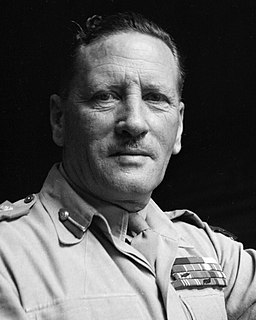 W
WField Marshal Sir Claude John Eyre Auchinleck, was a British Army commander during the Second World War. He was a career soldier who spent much of his military career in India, where he rose to become Commander-in-Chief of the Indian Army by early 1941. In July 1941 he was appointed Commander-in-Chief of the Middle East Theatre, but after initial successes, the war in North Africa turned against the British, and he was relieved of the post in 1942 during the crucial Alamein campaign.
 W
WLieutenant General Sir Edward Barnes, was a British soldier who became governor of Ceylon.
 W
WLieutenant General Lord William Henry Cavendish-Bentinck, known as Lord William Bentinck, was a British soldier and statesman. He served as Governor-General of India from 1828 to 1835. He has been credited for significant social and educational reforms in India, including abolishing sati, suppressing female infanticide and human sacrifice. Bentinck said that "the dreadful responsibility hanging over his head in this world and the next, if… he was to consent to the continuance of this practice (sati) one moment longer." Bentinck after consultation with the army and officials passed the Bengal Sati Regulation, 1829 there was little opposition. The only challenge came from the Dharma Sabha which appealed in the Privy Council, however the ban on Sati was upheld. He ended lawlessness by eliminating thuggee – which had existed for over 450 years – with the aid of his chief captain, William Henry Sleeman. Along with Thomas Babington Macaulay he introduced English as the language of instruction in India.
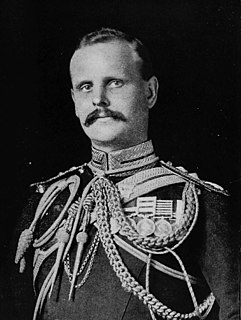 W
WField Marshal William Riddell Birdwood, 1st Baron Birdwood, was a British Army officer. He saw active service in the Second Boer War on the staff of Lord Kitchener. He saw action again in the First World War as Commander of the Australian and New Zealand Army Corps during the Gallipoli Campaign in 1915, leading the landings on the peninsula and then the evacuation later in the year, before becoming commander-in-chief of the Fifth Army on the Western Front during the closing stages of the war. He went on to be general officer commanding the Northern Army in India in 1920 and Commander-in-Chief, India, in 1925.
 W
WField Marshal Philip Walhouse Chetwode, 1st Baron Chetwode, 7th Baronet of Oakley,, was a senior British Army officer. He saw action during the Second Boer War, during which he was present at the Siege of Ladysmith in December 1899. He saw action again during World War I on the Western Front, taking part in the First Battle of Ypres, and then in the Sinai and Palestine campaign during which he led his corps at the First Battle of Gaza in March 1917, at the Battle of Beersheba in October 1917 and the Battle of Jerusalem in November 1917.
 W
WSir Alured Clarke was a British Army officer. He took charge of all British troops in Georgia in May 1780 and was then deployed to Philadelphia to supervise the evacuation of British prisoners of war at the closing stages of the American Revolutionary War. He went on to be Governor of Jamaica and then lieutenant-governor of Lower Canada in which role he had responsibility for implementing the Constitutional Act 1791. He was then sent to India where he became Commander-in-Chief of the Madras Army, then briefly Governor-General of India and finally Commander-in-Chief of India during the Fourth Anglo-Mysore War.
 W
WMajor-General Robert Clive, 1st Baron Clive, also known as Clive of India, was the first British Governor of the Bengal Presidency. He is credited along with Warren Hastings for laying the foundation of British rule in India. He began as a writer for the East India Company (EIC) who established the military and political supremacy of the EIC on the Indian subcontinent by winning the Battle of Plassey. In return for supporting the Nawab of Bengal Mir Jafar on the throne, Clive was granted a jaghire of £30,000 per year which was the rent the EIC would otherwise pay to the Nawab for their tax farming concession. When he left India he had a fortune of £180,000 which he remitted through the Dutch East India Company.
 W
WField Marshal Stapleton Cotton, 1st Viscount Combermere, was a British Army officer, diplomat and politician. As a junior officer he took part in the Flanders Campaign, in the Fourth Anglo-Mysore War and in the suppression of Robert Emmet's insurrection in 1803. He commanded a cavalry brigade in Sir Arthur Wellesley's Army before being given overall command of the cavalry in the latter stages of the Peninsular War. He went on to be Commander-in-Chief, Ireland and then Commander-in-Chief, India. In the latter role he stormed Bharatpur—a fort which previously had been deemed impregnable.
 W
WLieutenant-General Sir Eyre Coote, KB was a British soldier and politician who sat in the House of Commons from 1768 to 1780. He is best known for his many years of service with the British Army in India. His victory at the Battle of Wandiwash is considered a decisive turning point in the struggle for control in India between Britain and France. He was known by his sepoy troops as Coote Bahadur.
 W
WCharles Cornwallis, 1st Marquess Cornwallis,, styled Viscount Brome between 1753 and 1762 and known as the Earl Cornwallis between 1762 and 1792, was a British Army general and official. In the United States and the United Kingdom he is best remembered as one of the leading British generals in the American War of Independence. His surrender in 1781 to a combined American and French force at the siege of Yorktown ended significant hostilities in North America. He later served as a civil and military governor in Ireland, where he helped bring about the Act of Union; and in India, where he helped enact the Cornwallis Code and the Permanent Settlement.
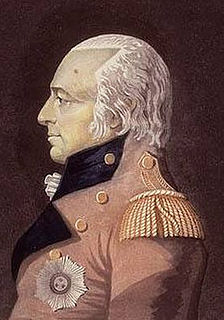 W
WGeneral Sir James Henry Craig KB was a British military officer and colonial administrator.
 W
WGeneral Sir Garrett O'Moore Creagh, known as Sir O'Moore Creagh, was a senior British Army officer and an Irish recipient of the Victoria Cross, the highest award for gallantry in the face of the enemy that can be awarded to British and Commonwealth forces.
 W
WGeneral George Ramsay, 9th Earl of Dalhousie,, styled Lord Ramsay until 1787, and Baron Dalhousie from 1815, was a Scottish soldier and colonial administrator. He was Governor of Nova Scotia from 1816 to 1820, Governor General of British North America from 1820 to 1828 and later Commander-in-Chief in India. In turn, his son, James Andrew Broun-Ramsay, 1st Marquess of Dalhousie, would later serve as Governor-General of India.
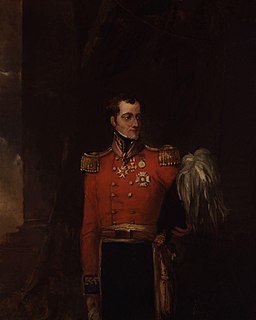 W
WField Marshal Sir William Maynard Gomm was a British Army officer. After taking part in the Anglo-Russian invasion of Holland, he served in most of the battles of the Napoleonic Wars. During the Hundred Days he took part in both the Battle of Quatre Bras and the Battle of Waterloo. He went on to be Commander of the troops in Jamaica and in that role established new barracks at Newcastle, Jamaica, high in the mountains. After that he became Governor of Mauritius and, finally, Commander-in-Chief, India, in which role he introduced promotion examinations for officers.
 W
WField Marshal Hugh Gough, 1st Viscount Gough, was a British Army officer. After serving as a junior officer at the seizure of the Cape of Good Hope during the French Revolutionary Wars, Gough commanded the 2nd Battalion of the 87th Regiment of Foot during the Peninsular War. After serving as commander-in-chief of the British forces in China during the First Opium War, he became Commander-in-Chief, India and led the British forces in action against the Marathas defeating them decisively at the conclusion of the Gwalior Campaign and then commanded the troops that defeated the Sikhs during both the First Anglo-Sikh War and the Second Anglo-Sikh War.
 W
WField Marshal Sir Patrick Grant, was a senior Indian Army officer. He fought at the Battle of Maharajpore during the Gwalior Campaign, at the Battle of Mudki, the Battle of Ferozeshah and the Battle of Sobraon during the First Anglo-Sikh War and at the Battle of Chillianwala and the Battle of Gujrat during the Second Anglo-Sikh War. During the Indian Mutiny, as acting Commander-in-Chief, India, he directed the operations against the mutineers, sending forces under Henry Havelock and James Outram for the relief of Cawnpore and Lucknow. He later became Governor of Malta.
 W
WFrancis Edward Rawdon-Hastings, 1st Marquess of Hastings, KG, PC, styled The Honourable Francis Rawdon from birth until 1762, Lord Rawdon between 1762 and 1783, The Lord Rawdon from 1783 to 1793 and The Earl of Moira between 1793 and 1816, was an Anglo-Irish politician and military officer who served as Governor-General of India from 1813 to 1823. He had also served with British forces for years during the American Revolutionary War and in 1794 during the War of the First Coalition. He took the additional surname "Hastings" in 1790 in compliance with the will of his maternal uncle, Francis Hastings, 10th Earl of Huntingdon.
 W
WField Marshal Sir Claud William Jacob, was a British Indian Army officer. He served in the First World War as commander of the Dehra Dun Brigade, as General Officer Commanding 21st Division and as General Officer Commanding II Corps in the Fifth Army. During the Battle of the Somme, his corps undertook the British attack during the Battle of Thiepval Ridge in September 1916 and the subsequent assault on St Pierre Divion during the Battle of the Ancre in November 1916. He remained in command of II Corps for the Battle of Passchendaele in Autumn 1917. After the War he commanded a corps of the British Army of the Rhine during the occupation there and then served as Chief of the General Staff in India. He went on to be General Officer Commanding Northern Command in India before temporarily becoming Commander-in-Chief, India and then taking over as Military Secretary to the India Office.
 W
WHoratio Herbert Kitchener, 1st Earl Kitchener was an Irish-born senior British Army officer and colonial administrator. Kitchener won notoriety for his imperial campaigns, especially his scorched earth policy against the Boers, his expansion of Lord Roberts' internment camps during the Second Boer War and his central role in the early part of the First World War.
 W
WGerard Lake, 1st Viscount Lake was a British general. He commanded British forces during the Irish Rebellion of 1798 and later served as Commander-in-Chief of the military in British India.
 W
WMajor-General Stringer Lawrence was an English soldier, the first Commander-in-Chief, India
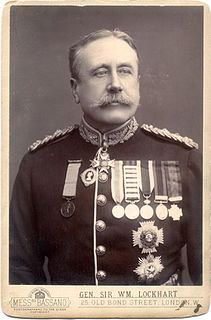 W
WGeneral Sir William Stephen Alexander Lockhart was a British General in the British Indian Army.
 W
WGeneral Sir Charles Carmichael Monro, 1st Baronet, was a British Army General in the First World War. He held the post of Commander-in-Chief, India in 1916–1920. From 1923 to 1929 he was the Governor of Gibraltar.
 W
WGeneral Sir Hector Munro, 8th laird of Novar KB was a British soldier who became the ninth Commander-in-Chief of India (1764–1765).
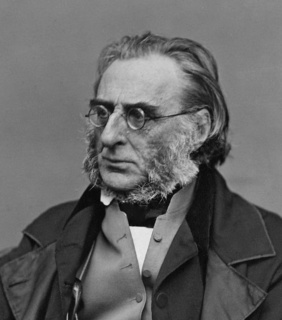 W
WGeneral Sir Charles James Napier, was an officer and veteran of the British Army's Peninsular and 1812 campaigns, and later a Major General of the Bombay Army, during which period he led the military conquest of Sindh, before serving as the Governor of Sindh, and Commander-in-Chief in India.
 W
WSir George Nugent, 1st Baronet, GCB was a British Army officer. After serving as a junior officer in the American Revolutionary War, he fought with the Coldstream Guards under the Duke of York during the Flanders Campaign. He then commanded the Buckinghamshire Volunteers in the actions of St. Andria and Thuyl on the river Waal and participated in the disastrous retreat from the Rhine. He went on to be commander of the northern district of Ireland, in which post he played an important part in placating the people of Belfast during the Irish Rebellion, and then became Adjutant-General in Ireland. He went on to be Governor of Jamaica, commander of the Western District in England, commander of the Kent District in England and finally Commander-in-Chief, India.
 W
WGeneral Sir Edward Paget was a British Army officer.
 W
WGeneral Sir Arthur Power Palmer, was Commander-in-Chief, India between March 1900 and December 1902.
 W
WGeneral Henry Seymour Rawlinson, 1st Baron Rawlinson,, known as Sir Henry Rawlinson, 2nd Baronet between 1895 and 1919, was a senior British Army officer in the First World War who commanded the Fourth Army of the British Expeditionary Force at the battles of the Somme (1916) and Amiens (1918) as well as the breaking of the Hindenburg Line (1918). He commanded the Indian Army from 1920 to 1925.
 W
WField Marshal Frederick Sleigh Roberts, 1st Earl Roberts,, was a British Victorian era general who became one of the most successful British military commanders of his time. Born in India to an Anglo-Irish family, Roberts joined the East India Company Army and served as a young officer in the Indian Rebellion during which he was awarded the Victoria Cross for gallantry. He was then transferred to the British Army and fought in the Expedition to Abyssinia and the Second Anglo-Afghan War, in which his exploits earned him widespread fame. Roberts would go on to serve as the Commander-in-Chief, India before leading British Forces for a year during the Second Boer War. He also became the last Commander-in-Chief of the Forces before the post was abolished in 1904.
 W
WGeneral William Rose Mansfield, 1st Baron Sandhurst was a British military commander who served as Commander-in-Chief of India from 1865 to 1870.
 W
WField Marshal Sir Donald Martin Stewart, 1st Baronet, was a senior Indian Army officer. He fought on the Aka Khel Expedition to the North-West Frontier in 1854, took part in the response to the Indian Rebellion in 1857 and, after serving as commandant of the penal settlement of the Andaman Islands, fought in the Second Anglo-Afghan War as Commander of the Quetta Army. In that role, he advanced through the Bolan Pass to Quetta, and then on to Kandahar in January 1879. In March 1880, he made a difficult march from Kandahar to Kabul, fighting on the way the Battle of Ahmed Khel and Battle of Arzu, and then holding supreme military and civil command in northern Afghanistan. He became Commander-in-Chief, India in April 1881 and a member of the Council of the Secretary of State for India in 1893.
 W
WField Marshal Hugh Henry Rose, 1st Baron Strathnairn, was a senior British Army officer. He served as a military adviser to the Ottoman Army who were seeking to secure the expulsion of the forces of Mehemet Ali from Syria during the Egyptian–Ottoman War. He then fought with the French Army at the Battle of Alma, the Battle of Inkerman and at the Battle of Mamelon during the Crimean War. During the Indian Rebellion of 1857 Rose was given command of the Central Indian Field Force and defeated the armies at Jhansi in April 1858, at Lahore in May 1858 and at Gwalior in June 1858. He went on to be Commander of the Bombay Army, Commander-in-Chief, India and then Commander-in-Chief, Ireland.
 W
WField Marshal Archibald Percival Wavell, 1st Earl Wavell, was a senior officer of the British Army. He served in the Second Boer War, the Bazar Valley Campaign and World War I, during which he was wounded in the Second Battle of Ypres. He served in the Second World War, initially as Commander-in-Chief Middle East, in which role he led British forces to victory over the Italians in western Egypt and eastern Libya during Operation Compass in December 1940, only to be defeated by the German Army in the Western Desert in April 1941. He served as Commander-in-Chief, India, from July 1941 until June 1943 and then served as Viceroy of India until his retirement in February 1947.
 W
WField Marshal Sir George Stuart White, was an officer of the British Army. He was stationed at Peshawar during the Indian Mutiny and then fought at the Battle of Charasiab in October 1879 and at the Battle of Kandahar in September 1880 during the Second Anglo-Afghan War. For his bravery during these two battles, he was awarded the Victoria Cross. He went on to command a brigade during the Third Anglo-Burmese War in 1886 and became commander of Quetta District in 1889 in which role he led operations in the Zhob Valley and in Balochistan. He was commander of the forces in Natal at the opening of the Second Boer War and fought at the Battle of Elandslaagte in October 1899. He commanded the garrison at the siege of Ladysmith: although instructed by General Sir Redvers Buller to surrender the garrison he responded "I hold Ladysmith for the Queen" and held out for another four months before being relieved in February 1900. He finished his career as Governor of Gibraltar and then as Governor of the Royal Hospital Chelsea.